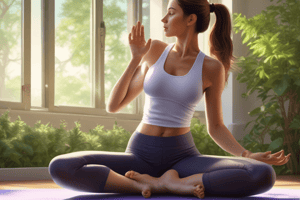Podcast
Questions and Answers
What is the original meaning of the word 'yoga,' from its Sanskrit root 'yuj'?
What is the original meaning of the word 'yoga,' from its Sanskrit root 'yuj'?
- To meditate
- To stretch
- To relax
- To join or attach (correct)
Yoga primarily focuses on physical health, with minimal impact on mental and emotional well-being.
Yoga primarily focuses on physical health, with minimal impact on mental and emotional well-being.
False (B)
Name three benefits of practicing yoga, besides increasing flexibility and strength.
Name three benefits of practicing yoga, besides increasing flexibility and strength.
Attainment of perfect balance and harmony, self-healing, removal of negative blocks from the mind and toxins from the body. (Any three from the BENEFITS OF YOGA list)
During postural movements in yoga, it's important to maintain focus on both ______ and ______.
During postural movements in yoga, it's important to maintain focus on both ______ and ______.
Match the breathing techniques with their descriptions:
Match the breathing techniques with their descriptions:
Why is warming up and stretching important before performing yoga exercises?
Why is warming up and stretching important before performing yoga exercises?
Shibashi exercise primarily focuses on physical health. It has little effect on mental and emotional health.
Shibashi exercise primarily focuses on physical health. It has little effect on mental and emotional health.
Besides flexibility and strength, what other physical benefits does yoga provide?
Besides flexibility and strength, what other physical benefits does yoga provide?
Yoga helps decrease stress and tension in the physical body by activating the ______ nervous system.
Yoga helps decrease stress and tension in the physical body by activating the ______ nervous system.
Match the yoga pose with its description:
Match the yoga pose with its description:
Which of the following is NOT a direction that can be applied in yoga?
Which of the following is NOT a direction that can be applied in yoga?
It is recommended to hold your breath for 15 seconds after exhaling during controlled breathing in yoga.
It is recommended to hold your breath for 15 seconds after exhaling during controlled breathing in yoga.
What does Surya Namaskar mean literally?
What does Surya Namaskar mean literally?
In the yoga pose, Thunderbolt it also known as ______.
In the yoga pose, Thunderbolt it also known as ______.
Match the pose with its common name:
Match the pose with its common name:
What is the main focus of seated forward pose?
What is the main focus of seated forward pose?
The Tree Pose is a Seated Pose.
The Tree Pose is a Seated Pose.
What three poses are possible from the supine position?
What three poses are possible from the supine position?
Standing Forward Bend Pose is also know as ______.
Standing Forward Bend Pose is also know as ______.
Match the following descriptions to the poses:
Match the following descriptions to the poses:
Flashcards
What is Yoga?
What is Yoga?
An ancient Indian exercise that builds strength and flexibility, boosting physical and mental well-being through posture and breathing.
What are yoga's benefits?
What are yoga's benefits?
Achieving balance, self-healing, removing blocks, increasing awareness and focus, decreasing stress, and improving relationships and wellness.
Posture in Yoga
Posture in Yoga
Holding a steady position, controlling wobbles, moving slowly, and focusing on breath and posture.
Relaxation Techniques
Relaxation Techniques
Conscious breathing, lengthening exhalations, contracting/relaxing muscles, and body sensation awareness.
Signup and view all the flashcards
Breathing Techniques
Breathing Techniques
Inhaling, briefly holding, exhaling, and briefly holding after exhaling.
Signup and view all the flashcards
Flexion
Flexion
Bending forward.
Signup and view all the flashcards
Extension
Extension
Bending backward.
Signup and view all the flashcards
Lateral Flexion
Lateral Flexion
Bending sideways.
Signup and view all the flashcards
Rotation
Rotation
Twisting.
Signup and view all the flashcards
What are yoga poses?
What are yoga poses?
Physical poses that exercise the entire body, stretching and toning muscles and joints.
Signup and view all the flashcards
Sun Salutation
Sun Salutation
Translated from Sanskrit, 'Surya' means 'sun' and 'Namaskar' means 'to bow down to' or 'show gratitude'.
Signup and view all the flashcardsStudy Notes
- Consistent exercise enhances flexibility
- Warming up and stretching strengthens muscles
- Exercise is equally important as nutritious food, rest and relaxation for fitness
- Shibashi improves physical, mental and emotional health
Yoga
- Yoga will enable flexibility and strength to keep the body strong
- Effectiveness as intervention to some diseases has been tried out in studies
- It is a meditative instrument for cognition and overcoming release from inner peace
Topic 1 (Week 1): Objectives
- Understand basic yoga concepts
- Master breath control
- Articulate our body's benefits from performing Yoga activities
Yoga Origins
- Originated in India
- Derived from the word "yuj" meaning to add, join, or attach
- Ancient exercise form, builds strength and flexibility
- Considered therapy which boosts physical and mental well-being
- Components: posture and breathing.
Yoga Benefits
- Harmony
- Self-healing
- Mind and body toxin cleansing
- Higher Self Awareness
- Improved focus and concentration
- Stress and tension reduction
- Enhances parasympathetic nervous system
- Improves relationships
- Enables Physical Wellness
Critical Elements of Yoga
- Posture:
- Holding position for 6-8 breaths
- Controlling wobble/trembling
- Slow movements
- Focus on breath and posture
Relaxation/Breathing Techniques
- Active/dynamic relaxation:
- Breathing as a conscious act
- Eyes closed with deep, lengthened breaths
- Conscious muscle contraction/relaxation
- Focus on body sensations
- Breathing techniques:
- Nose breathing
- Controlled breathing
- Inhalation, retention after, exhalation, retention after
- Breathing deeply, expanding chest and abdomen
- Holding poses for 6-8 breaths (30 seconds)
Directions
- Flexion: Bending forward
- Extension: Bending Backward
- Lateral flexion: Bending sideways
- Rotation: Twisting
Topic 1 (Week 2): Objectives
- Identify easy and challenging yoga poses
- Perform proper breathing techniques
- Execute seated, standing, and supine poses properly
- Use correct techniques to minimize injuries
- Explain body benefits
Core Considerations
- Yoga poses exercise and tone the whole body and joints. Follow proper breathing and technique
- Elements required: posture, relaxation, and breathing
- Awareness of body movement directions improves flexibility and strength.
Variations
- Poses have different variations and difficulties based on the user's body needs.
Yoga Poses
- Seated poses:
- Easy Pose (Sukhasana)
- Thunderbolt Pose (Vajrasana)
- Butterfly Pose (Sukhasana)
- Boat Pose (Navasana)
- Child’s Pose (Balasana)
- Seated forward pose (Paschimottanasana)
- Standing Poses:
- Mountain Pose (Tadasana)
- Tree Pose (Virkshana)
- Warrior 1 Pose (Virabhadrasana 1)
- Warrior 2 Pose (Virabhadrasana 2)
- Warrior 3 Pose (Virabhadrasana 3)
- Triangle Pose (Utthita Trikonasana)
- Standing forward bend (Uttanasana)
- Downward Facing Dog (Adho Mukha Svanasana)
- Supine/On the floor Poses:
- Cobra Pose (Bhujangasana)
- Corpse Pose (Savasana)
- Plank (Phalakasana)
- Knees to Chest Pose (Apanasana)
- Bridge Pose (Setu Bandha Sarvangasana)
- Happy Baby Pose (Ananda Balasana)
Topic 1 (Weeks 3-4): Objectives
- Sun salutations a warm up
- Applying yoga elements
- Executing sequences with proper breathing
- Show body benefits
- Apply learned concepts through answering test
Sun Salutation
- Meaning: Surya (sun) and Namaskar (bow; showing gratitude)
- Hindu's ancient tradition of sun salutations did morning prayer, calming mind, yoga and disconnect from daily distractions.
- Now use a sun salutation as your warm up
Studying That Suits You
Use AI to generate personalized quizzes and flashcards to suit your learning preferences.




